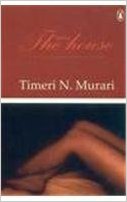Hmm. So Page 3 people in Chennai are just like Page 3 people in Delhi, or Mumbai, or anywhere! That’s the message of Timeri Murari’s new book, The Small House. Fittingly for a Page 3 story, this novel has a little bit of everything—the graceful and remote ex royal, her drunken scheming brother, the pushy Punjabi businessman-husband, the weepy pal from a minority community, and the closet gay husband— and of course, lots of air kissing!!! Roopmati, the main protagonist muses about this ‘habit…adopted from American and other foreign films and soap operas…’ (even the cover of the novel is perhaps inspired by Sex and the City?!) The Small House is an interesting read, for vignettes on Chennai life; it a story about changing times and beliefs and captures a particular moment in time—an almost sociological sketch. Beyond that, however, it fails to engage emotionally or otherwise.
The title of the novel refers to the practice of the ‘chinna veedu’ or small house, where rich men keep their mistresses. Roopmati, the ruminative ex-royal, discovers that her husband has one, and is fascinated enough by the idea to want to explore the small house, and even live in it. But the novel fails to explicate this fascination, and what could have potentially been a powerful moment dissolves in talk of champagne and dreams.
Roopmati herself is an unconvincing centre point, given to rather too much philosophical thought about history and India’s past versus its future. As an academic and a historian, she might be forgiven for this, but Timeri has her conversing with the legendary Rupmati (of Baz Bahadur fame) in what can only be described as ‘dream sequences’—filmi and unconvincing at best, schizophrenic at worst! The encounter episodes simply fail to work in the framework of the novel. In any case, her angst is the angst of a woman of plenty, with perhaps not enough to do … and her endless preoccupation with the past (hers or India’s) takes up all her time-and the readers!
The other characters too seem a tad plastic-y, and one can’t really engage with them. The book does make its point about changing society, in Chennai or elsewhere, and Murari sketches his characters neatly and deftly, so that they become recognizable but in the end they are stereotypes, and not much more. Tazneem muses on the copper miniature of the World Trade Tower, and the impact of its crash on her community, while Roopmati is incensed because her brother is part of the antique smuggling trade. Khris, Roopmati’s husband is the roaming, predatory Punjabi. To top it all, Maya, the ‘mistress’ is a cross between a wide eyed ingénue and a scheming corporate ladder—climber. You nod your head in recognition, and then move on. One also encounters the garrulous and gossipy salon owner, and surprisingly, a masseuse who is an expert on world economy and the stock market.
The lyrical and moving beauty of Murari’s earlier works such as Taj: A Story of Mughal India, and My Temporary Son is largely absent, glimpsed in flashes here, but without impact.
Sanam Khanna teaches English at Kamala Nehru College, Delhi University, Delhi.

